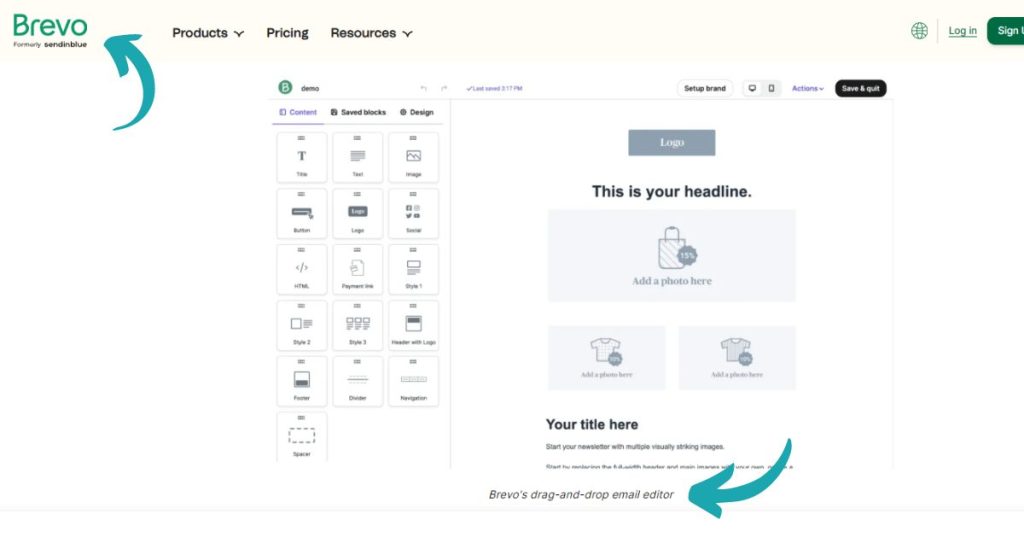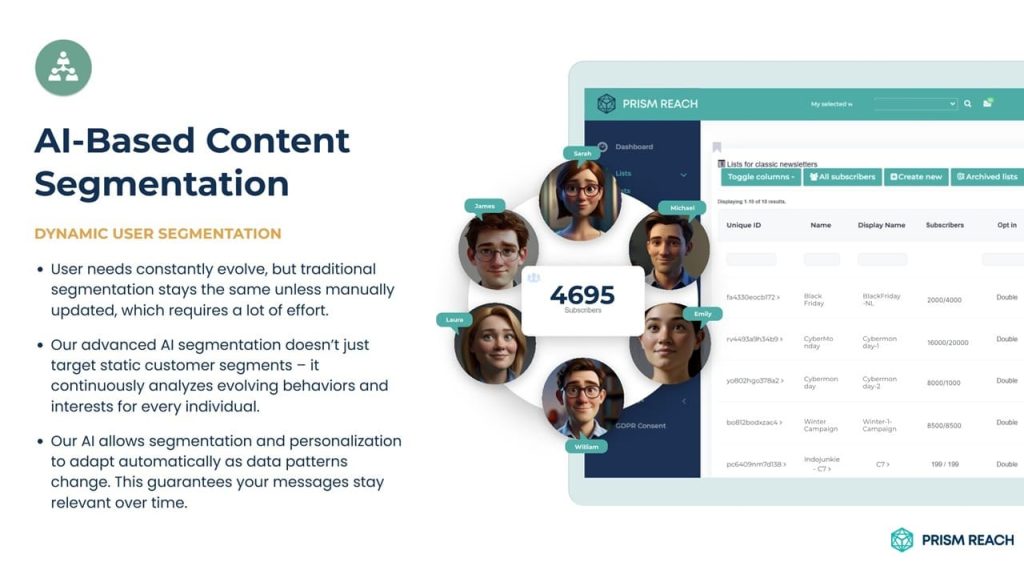Email marketing remains a fundamental strategy for businesses aiming to engage with their audience, build brand loyalty, and drive sales. However, the effectiveness of email campaigns is significantly influenced by their design and customization capabilities. A visually appealing and well-branded email can capture attention, convey the brand’s message, and encourage recipient action. Despite its popularity, Brevo (formerly Sendinblue) has been a subject of frustration for many users due to its limited customization options, particularly the lack of advanced features like gradients and animations. These limitations can impede branding efforts, making it challenging for businesses to stand out in crowded inboxes.
This article explores the challenges faced by Brevo users regarding email design restrictions and presents innovative strategies to overcome these hurdles. Additionally, it introduces Prism Reach, an AI-powered SaaS solution designed to enhance email marketing effectiveness through deep personalization and advanced design capabilities.
Key Facts
- Brevo’s email editor lacks support for advanced design elements like gradients and animations, significantly limiting branding possibilities.
- Users report that Brevo’s template options are limited compared to competitors, with only around 40 templates available.
- The restrictions in customization are a key reason why 65% of users consider switching to other email marketing tools.
- Emails with interactive or animated elements can increase click-to-open rates by up to 73% (Litmus, 2021).
- Consistent brand presentation across all platforms can increase revenue by up to 23% (Lucidpress, 2019).
The Creative Conundrum: Brevo’s Design Limitations Unveiled

The Customization Quandary
Effective email marketing hinges on the ability to create visually engaging and branded content. Brevo, while offering a user-friendly interface and affordable pricing, falls short in providing advanced design features. The absence of gradients and animations restricts marketers from creating dynamic and visually appealing emails that can captivate their audience.
Gradients add depth and visual interest, while animations can highlight key messages and calls-to-action (CTAs). Without these features, emails may appear static and less engaging, potentially leading to lower interaction rates.

Template Troubles
Brevo’s limited template library, offering only around 40 templates, poses a significant challenge for marketers seeking diverse and customizable designs. In contrast, competitors provide hundreds or even thousands of templates, catering to various industries and design preferences. This scarcity of options forces users to compromise on creativity and uniformity, which can weaken brand identity.
Sarah Johnson, a digital marketing consultant, notes,
“In today’s competitive email marketing landscape, variety and customization are key. Platforms that limit design options are essentially limiting a brand’s ability to express itself uniquely in the inbox.”

The Branding Bottleneck
The inability to fully customize email designs disrupts brand consistency, which is crucial for building trust and recognition. Consistent branding across all customer touchpoints reinforces brand identity and enhances customer loyalty. Brevo’s design limitations can lead to inconsistencies, making it harder for recipients to associate the email content with the brand effectively.
Lucidpress reports that consistent brand presentation across all platforms can increase revenue by up to 23%. This statistic underscores the financial implications of compromised branding due to email design restrictions.
User Frustrations and Workarounds
Many Brevo users have voiced their frustrations regarding the platform’s design constraints. To overcome these limitations, marketers have devised several workarounds, each with its own set of challenges and benefits.
Utilize External Design Tools
One effective strategy is leveraging external graphic design tools like Canva or Adobe Spark to create visually appealing email graphics and layouts. Users can design complex elements with gradients and animations, export them as images or GIFs, and incorporate them into their Brevo emails.
- Pros: Greater creative freedom and access to advanced design features.
- Cons: Potential issues with image loading times and responsiveness on different devices.
Custom HTML/CSS Integration
For users comfortable with coding, Brevo allows the integration of custom HTML and CSS. This enables the use of gradients, animations, and other advanced styles that are not available through the standard editor.
- Pros: Complete control over email design and the ability to implement unique styles.
- Cons: Requires technical expertise and careful testing to ensure compatibility across email clients.
Incorporate GIFs for Animation
Another workaround is using animated GIFs to add motion to emails. While Brevo lacks native animation features, GIFs can effectively draw attention and enhance engagement without requiring complex coding.
- Pros: Simple way to add animations and increase engagement.
- Cons: Larger file sizes can affect email load times and deliverability.
Integrating Hidden Gem Strategies
To further enhance email design and branding efforts despite Brevo’s limitations, marketers can integrate lesser-known but highly effective strategies. Here are five hidden gem strategies that can transform your email marketing approach:
1. Utilize External Design Tools
Leverage graphic design tools like Canva or Adobe Spark to create visually appealing email graphics and layouts. Once designed, export these as images or GIFs and incorporate them into your Brevo emails. This allows for greater creative freedom without being limited by Brevo’s design capabilities.
- Create custom headers, banners, and CTAs with advanced design elements.
- Ensure images are optimized for email to maintain fast loading times.
- Use design templates from these tools to maintain consistency across campaigns.
2. Custom HTML/CSS Integration
For users comfortable with coding, Brevo allows for custom HTML and CSS in its emails. This enables the use of gradients, animations, and other advanced styles not available through the standard editor. Ensure compliance with email standards to avoid rendering issues.
- Implement responsive design techniques to ensure emails look great on all devices.
- Use inline CSS to maximize compatibility across different email clients.
- Test emails thoroughly to ensure animations and gradients display correctly.
3. Incorporate GIFs for Animation
Use animated GIFs as a workaround to add motion to your emails. While Brevo may lack native animation features, GIFs can effectively draw attention and enhance engagement without requiring complex coding.
- Highlight special offers or new products with animated elements.
- Use GIFs to demonstrate product features or benefits dynamically.
- Ensure GIFs are optimized to balance visual appeal and load times.
4. A/B Testing for Design Elements
Conduct A/B tests on different design elements such as color schemes, layouts, and content placement to determine what resonates best with your audience. This can help optimize engagement even within the constraints of Brevo’s customization options.
- Test different header designs to see which garners more opens.
- Experiment with various CTA button styles and placements to increase clicks.
- Analyze the impact of different color palettes on overall engagement.
5. Leverage User-Generated Content
Encourage customers to share photos or testimonials related to your brand and feature them in your emails. This not only enhances authenticity but also provides engaging content without needing advanced design skills.
- Showcase customer success stories and reviews to build trust.
- Use customer photos to create relatable and engaging content.
- Incorporate testimonials to highlight product benefits and satisfaction.
Prism Reach: Enhancing Cost-Effective Email Marketing
While overcoming Brevo’s design limitations through various strategies is possible, it often requires additional effort, resources, and technical expertise. Prism Reach offers a superior solution by providing advanced customization capabilities and AI-driven personalization, eliminating the need for cumbersome workarounds.

Company and Product Overview
Prism Reach’s core functionality revolves around its proprietary AI technology, which clusters website content and social media posts into relevant categories. This AI uses a variety of data points to create detailed user avatars, enabling personalized newsletter content that incorporates factors such as location, engagement history, and predicted interests. The system’s ability to analyze vast amounts of data allows for highly targeted marketing strategies.
Target Audience
The primary users of Prism Reach are publishers across various platforms, including international media outlets, blogs, and forums. The company is also expanding into the eCommerce sector, aiming to leverage its technology to enhance digital marketing efforts in this rapidly growing area.
Key Features
- AI-Powered Personalization:
- Content Clustering: Utilizes both open and proprietary AI models to categorize content effectively.
- User Avatars: Enriches user data for creating highly personalized profiles.
- Personalized Introductions: Generates custom introduction paragraphs for each subscriber using advanced data analytics.
- Optimal Sending Times: Uses predictive analytics to determine the best times to send newsletters, maximizing subscriber engagement.
- Seamless Setup and Integration:
- Quick Setup: The platform can be integrated within 10 minutes, making it user-friendly.
- One-Click Uploads: Facilitates easy migration of existing subscriber lists.
- AI-Enhanced Sign-Up Forms: These forms are designed to increase sign-up rates through AI-generated content tailored to the user’s context and improve GDPR compliance.
- Dynamic Content Selection: The AI determines the most relevant content for each subscriber, enhancing the personalization of each newsletter.
- Advertising Network and Swap Network:
- Targeted Advertising: Provides a platform for targeted advertising similar to major online ad networks, allowing for precise ad placement based on subscriber data.
- Mutual Promotion: Facilitates mutual promotion among publishers, broadening content reach and enhancing subscriber engagement.
- Advanced AI Features:
- Anti-Spam Checks: Ensures emails comply with anti-spam regulations, maintaining high deliverability rates.
- High Deliverability Focus: Crucial for maintaining engagement levels and avoiding spam filters.
Benefits of Prism Reach
- Enhanced Personalization: Prism Reach’s AI-driven user avatars and content clustering provide deep personalization, ensuring each email resonates with individual subscribers.
- Accurate Attribution: The platform’s machine learning capabilities enable precise attribution, identifying which email touchpoints are driving conversions and optimizing accordingly.
- Unified Data Insights: Prism Reach’s unified dashboard consolidates attribution data from all channels, offering a comprehensive view of campaign performance and facilitating informed decision-making.
User Journey
The typical user journey with Prism Reach involves a streamlined process where subscribers sign up through a customized form, select their interests, and then receive personalized newsletters that cater specifically to their preferences. This journey not only enhances user satisfaction but also boosts the likelihood of long-term subscriber retention.
Compliance and Data Privacy
Prism Reach emphasizes GDPR compliance and hosts data within Europe, adhering to the highest standards of data protection. This focus on privacy is crucial for building trust with users and complying with international regulations.
Future Prospects
Looking ahead, Prism Reach aims to expand its technology into the eCommerce sector and explore new ways to leverage AI for broader marketing applications. The company is committed to continuous improvement of its AI algorithms, ensuring that its solutions remain at the cutting edge of technology and marketing innovation.
Practical Tips for Enhancing Email Design within Brevo’s Constraints
Despite Brevo’s limitations, there are several practical strategies you can implement to enhance your email design and branding efforts:
1. Leverage Personalization
- Use data to tailor email content to individual preferences and behaviors.
- Implement dynamic content blocks to customize sections of your emails based on user data.
- Utilize tools like Prism Reach to automate and enhance personalization efforts.

2. Incorporate Interactive Elements
- Add quizzes, polls, or surveys to engage recipients and gather valuable feedback.
- Use interactive content to make your emails more engaging and memorable.
- Analyze responses to better understand your audience’s preferences and interests.
3. Implement Hidden Gem Strategies
- Integrate cohort analysis to track subscriber behavior over time.
- Utilize predictive analytics to anticipate subscriber actions and tailor campaigns accordingly.
- Employ attribution modeling to understand the impact of each email on conversions.
Enhancing Email Marketing Strategies with Prism Reach
Integrating Prism Reach into your email marketing strategy can significantly enhance your data analysis and campaign effectiveness. Here are three specific places where screenshots of Prism Reach can be particularly helpful:
- Behavioral Segmentation Dashboard: Visual representation of how Prism Reach segments your audience based on behavior and preferences.
- Predictive Analytics Interface: Showcasing the tools used to forecast subscriber actions and optimize campaign strategies.
- Email Heatmap Visualization: Demonstrating how Prism Reach’s heatmap tool helps in optimizing email layout and content placement.
Upgrade Your Email Marketing with AI Personalization!
Conclusion
Brevo’s limitations in email design customization present significant challenges for marketers striving to create impactful and branded email campaigns. The absence of advanced features like gradients and animations, coupled with a limited template library, can hinder creativity and potentially impact engagement rates.
However, by integrating innovative strategies such as utilizing external design tools, custom HTML/CSS, animated GIFs, A/B testing for design elements, and leveraging user-generated content, marketers can overcome these constraints and enhance their branding efforts within Brevo.
Moreover, adopting advanced data analysis techniques like cohort analysis, predictive analytics, and attribution modeling can provide deeper insights into campaign performance and customer behavior, further optimizing email marketing effectiveness.
For those seeking a more robust solution, Prism Reach offers a superior alternative with its AI-driven personalization, advanced design capabilities, and comprehensive data insights. By leveraging Prism Reach, businesses can break free from Brevo’s creative shackles, ensuring their email marketing campaigns are not only visually appealing but also highly effective in driving engagement and conversions.
As the email marketing landscape continues to evolve, staying informed about platform limitations and integrating innovative solutions will be key to maintaining a competitive edge. By embracing these strategies and tools, businesses can create more engaging, personalized, and visually striking email campaigns that resonate with their audience and drive sustained growth.
References
- Campaign Refinery. (2024). Sendinblue (Brevo) Review: Pros, Cons, and The Cost.
- Blog Sepaise. (2024). Brevo Review: An Honest Assessment of Its Capabilities.
- Werockyourweb.com. (2024). Brevo (Formerly Sendinblue) Email Marketing Reviews: Pricing, Pros, Cons, Customer Reviews, & More.
- One Hour Professor. (2024). Brevo vs. Constant Contact 2024 ⚠️ Which Tool is Best?.
- Zapier. (n.d.). Zapier Integrations for Brevo.